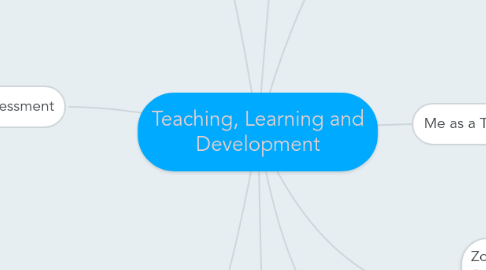
1. Psychology
1.1. Schwab's Four Common Places
1.1.1. The teacher teaches the curriculum to the student in the classroom
1.2. Developmental Influences
1.2.1. Physical/biological
1.2.2. Cognitive/learning
1.3. Stiggin's Achievement Target
1.3.1. Specifications of what students should learn or do
1.4. Carol Dweck:The Power of Believing You Can Improve
1.4.1. Growth Mindset: The underlying beliefs people have about learning and intelligence
1.5. Bloom's Taxonomy
1.5.1. Hierarchical series of intellectual abilities involved in the acquisition and use of knowledge
2. Assessment
2.1. Students Assessment
2.1.1. Purpose
2.1.2. Formative
2.1.3. Developing tests
2.1.4. Design question and exams
2.2. Testing Issues
2.2.1. Achievement vs. aptitude tests
2.3. Types of Assessment
2.4. Assessing Issues
2.5. Response questions
2.6. Types of assessment
2.7. Standardised Tests
2.7.1. The differences between standardised tests
2.7.2. Connections between curricula and standardised tests
2.7.3. Characteristics of a Standardised Test
2.7.3.1. Same questions for all test-takers
2.7.3.2. Administered in the same fashion
2.7.3.3. Scored in a uniform manner
2.7.4. Criteria-referenced vs norm-referenced
3. Teaching Strategies
3.1. Concept of Intelligence
3.1.1. Gardner’s and Sternberg’s Models of Intelligence
3.2. Special Education
3.2.1. What do I know about special education in Canada?
3.3. IEP: Individualised Education Program
3.4. Strategies for Cooperative Learning
3.4.1. Backwards Design: Begin with what I want my students to learn? ending with how will I teach?
3.5. Inquiry Based Learning
3.5.1. Posing questions, problems or scenarios
3.6. How People Learn
3.6.1. Learner Centered
3.6.2. Knowledge Centered
3.6.3. Assessment Centered
3.6.4. Community Centered
3.7. Cognitive strategy
3.7.1. Actively promotes understanding and retention of knowledge
4. Zoe Branigan-Pipe - Letting Students Hack Their Lesson Plan
4.1. Never underestimate what your students are capable of
5. Deciding on an approach for classroom management
6. The Aim of Education
6.1. Seth Godin:Stop Stealing Dreams *What is school for?
6.2. Rita Pierson:Every Kid Needs a Champion *Kids don't learn from people they dont like
7. Me as a Teacher
7.1. Reflect on your favourite teacher's instructional method
7.2. Learning styles quiz: "You teach who you are"
7.3. My abilities and challenges that influenced my school experiences and career path
8. Classroom Management
8.1. Adora Svita:What Adults Can Learn from Kids
8.2. Establishing a positive learning environment
8.3. Dynamic Classroom Management
8.3.1. incorporates most current research principles available in discipline
8.4. Tips for Classroom Management
8.4.1. Build community
8.4.2. Always be calm
8.4.3. Know the students you teach
8.4.4. Keep it real
8.4.5. Address conflict quickly
8.4.6. Include students when creating rules
8.4.7. Partner with parents
8.4.8. Create a variety of communication channels
8.4.9. Integrate positive rituals
8.4.10. Keep environment safe and friendly
8.5. What is Classroom Management?
8.5.1. The actions teachers undertake to create environments that support and enhance academic learning and appropriate social skill development
9. Socio Cultural Considerations
9.1. Inclusion
9.1.1. Including students with exceptionalities
9.2. Labelling and education placements
9.3. influence of individual and community
9.4. General considerations
9.5. Cultural Differences: Diverse Learners
9.6. Stereotypes
9.7. Multicultural Education
9.7.1. To understand each student's personal identity and how it is formed relative to their associations with various groups
9.8. Student Cultural Backgrounds
9.9. Strategies for Working with Diverse Learners
9.9.1. Demonstration of high expectations
9.9.2. Culturally relevant instruction
9.9.3. Establishing a caring relationship
9.9.4. Parent and community involvement
